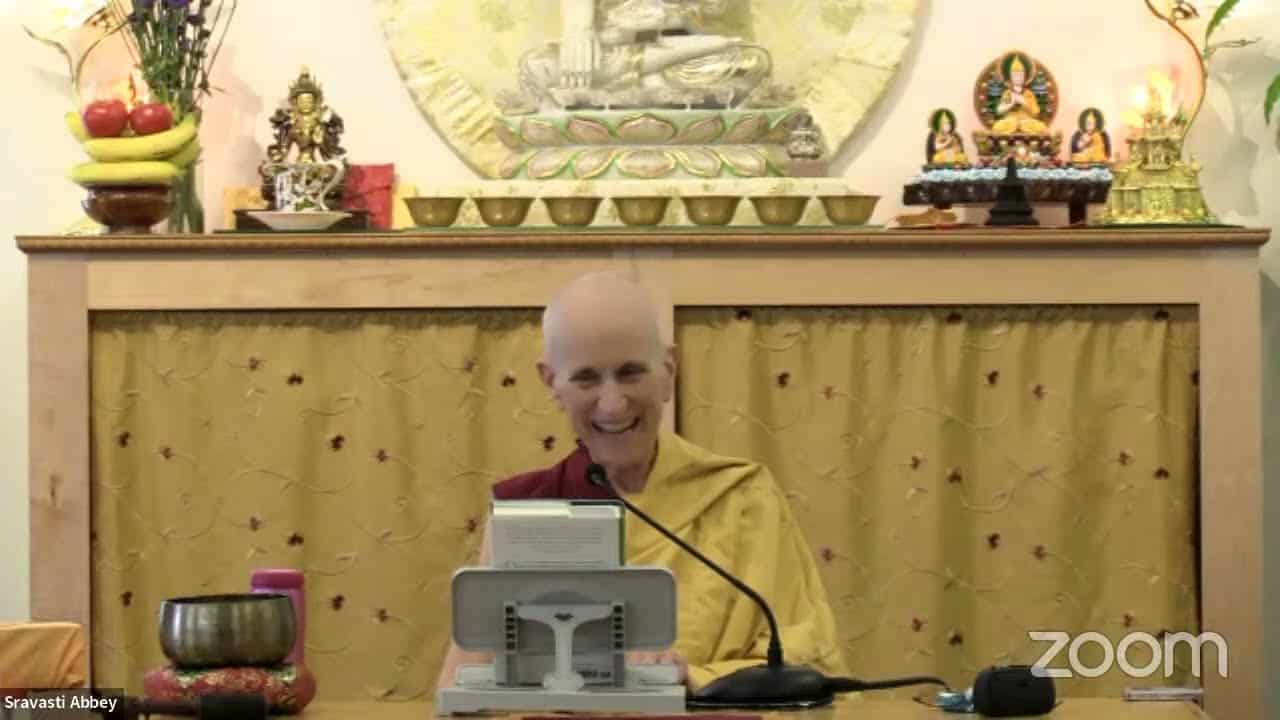The existence of the Three Jewels
02 Following in the Buddha's Footsteps
Part of an ongoing series of teachings based on the book Following in the Buddha's Footsteps, the fourth volume in The Library of Wisdom and Compassion series by His Holiness the Dalai Lama and Venerable Thubten Chodron.
- Forward and reverse sequence for cultivating refuge, renunciation and bodhicitta for entering a path
- Four truths and two truths
- Reasons for taking refuge
- Types of obscurations to the mind for knowing phenomena
- Three qualities of the mind
- Nagarjuna’s reasoning for proving the existence of the Three Jewels
02 The existence of the Three Jewels (download)
Contemplation points
- Bodhicitta is based on great compassion, but to feel great compassion for others, we must first have compassion for ourselves. Often, we think this means indulging in objects of sense pleasure. What is the true meaning of self-compassion in the Buddhist worldview?
- Contemplate the forward sequence:
- Taking refuge is the door to enter the Buddha’s doctrine by making us receptive and giving direction to our spiritual yearnings.
- Refuge opens our minds to contemplate dukkha , the unsatisfactory conditions of samsara. Seeing that there is no final happiness to be had in samsara, we renounce dukkha and aspire for liberation. This is the door to enter the paths of sravaka, solitary realiser, and bodhisattva.
- Seeing that all sentient beings, who have been kind to us from the beginningless lifetimes, are trapped in samsara, we cultivate great compassion and aspire for full awakening in order to help them escape from samsara. This bodhicitta motivation is the door to the Mahayana. Motivated and informed by bodhicitta, we generate the wisdom realising the emptiness of inherent existence, which removes all obscurations and enables us to attain buddhahood.
- Contemplate the reverse sequence, seeing that realisation of emptiness on the Mahayana path is fuelled by bodhicitta, which is generated through having great compassion for all living beings. This, in turn, depends on having the aspiration to be free from samsara, which relies on having taken refuge in the three Three Jewels.
- Contemplate the causes to take refuge in the Three Jewels to deepen your insight:
- Reflect on the faults of rebirth in unfortunate realms and cyclic existence in general.
- Reflect on the excellent qualities of the Three Jewels that make them trustworthy objects of refuge.
- With compassion for others who are bound to samsara by afflictions and karma, generate the aspiration for full awakening.
- With relief and confidence, turn to the Three Jewels as reliable guides to actualize your spiritual aims.
- The buddhas’ minds are free from all the obscurations that hinder our own minds and because of their compassion, they have the ability to effortlessly and spontaneously benefit all living beings. Spend some time considering the fact that our ability to to experience this benefit depends on our own receptivity. Are there situations, environments, beliefs, actions in your own life that hinder your receptivity? What can you do to increase your receptivity of the buddhas’ enlightened activities?
- According to your present understanding, reflect that liberation is possible.
- The basic nature of the mind is pure and clear.
- Afflictions are based on ignorance that apprehends phenomena in the opposite way than they actually exist. Thus ignorance and afflictions born from it are adventitious and do not inhere in the nature of the mind.
- It is possible to cultivate powerful antidotes – realistic and beneficial mental states such as the wisdom realizing the emptiness – which root out ignorance, afflictions and other obscurations.
- Remember these three points, and as your understanding of the mind expands, come back and reflect on them again.
Venerable Thubten Chodron
Venerable Chodron emphasizes the practical application of Buddha’s teachings in our daily lives and is especially skilled at explaining them in ways easily understood and practiced by Westerners. She is well known for her warm, humorous, and lucid teachings. She was ordained as a Buddhist nun in 1977 by Kyabje Ling Rinpoche in Dharamsala, India, and in 1986 she received bhikshuni (full) ordination in Taiwan. Read her full bio.


